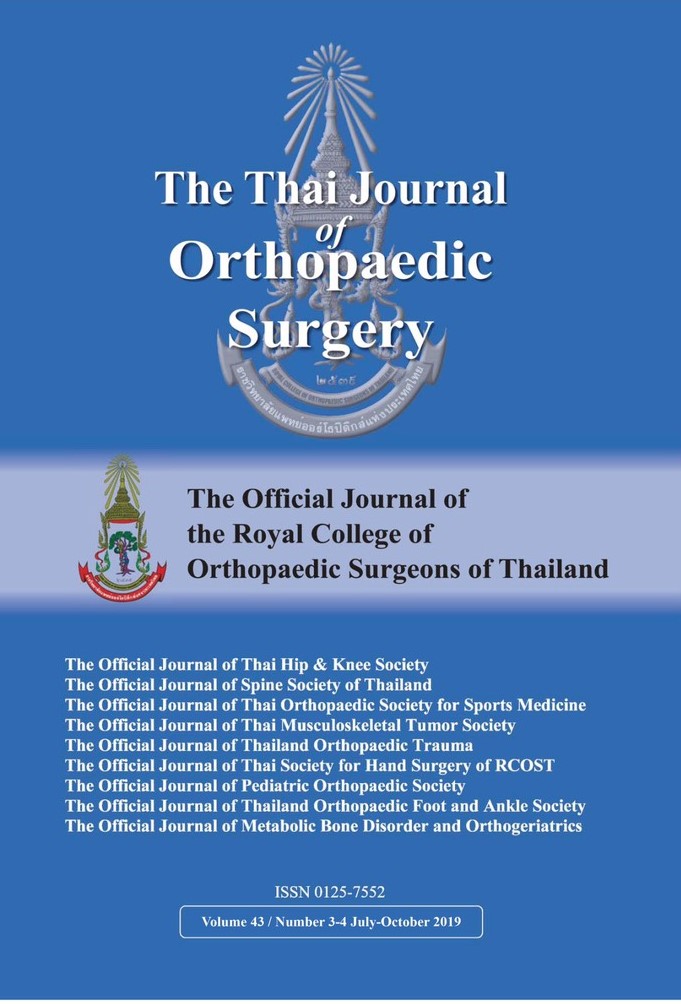The Use of Combining a Smartphone and a Digital Angle Ruler Technique to Assist Acetabular Cup Placement: A Clinical Study
Main Article Content
Abstract
Purpose: To evaluate the percentage of acetabular cups that were correctly placed within the Lewinnek safe zone and the accuracy of the combined use of a smartphone and a digital angle ruler technique in assisting the placement of the acetabular cup by comparing the intraoperative values of acetabular cup inclination and anteversion to postoperative radiographic and CT scan measurements.
Materials and Methods: This prospective observational study included 23 hips upon which were performed primary total hip arthroplasty through a lateral transgluteal approach in supine position. The combined use of a smartphone and a digital angle ruler technique was used for the reamers and cup positioning during acetabular reaming steps and final cup implantation. Postoperatively, a multislice CT scan was obtained at one month or later for cup anteversion measurement including a standard plain film of both hips in true anteroposterior position for cup inclination evaluation compared to the intraoperative values by using a paired t-test with a 0.05 level of significance.
Results: The mean radiographic inclination (RI) angle from the digital angle ruler was 42.1º (SD 2.4). The mean RI angle from the postoperative radiographic measurement was 42.2º (SD 5.3). The mean paired difference was 0.39○ (SD 4.8), this difference was not significant (p = 0.97). The mean radiographic anteversion (RA) angle from the smartphone was 7.4º (SD 3.1).The mean RA from the postoperative CT scan was 11.9º (SD 5.9). The mean paired difference was 4.52○ (SD 4.3), this difference was significant (p< 0.05). The percentage of cup placements in the Lewinnek safe zone was 82.61%.
Conclusion: The use of smartphone application combined with a digital angle ruler could provide an acceptable percentage of cup placements within the Lewennek safe zone and the inclination measurements were more accurate than the anteversion measurements.
Article Details
References
2. Hirakawa K, Mitugi N, Koshino T, Saito T, Hirasawa Y, Kubo T. Effect of acetabular cup position and orientation in cemented total hip arthroplasty. Clin Orthop Relat Res. 2001; (388): 135-42.
3. Little NJ, Busch CA, Gallagher JA, Rorabeck CH, Bourne RB. Acetabular polyethylene wear and acetabular inclination and femoral offet. Clin Orthop Relat Res. 2009; 467(11): 2895-900.
4. Lewinnek GE, Lewis JL, Tarr R, Compere CL, Zimmerman JR. Dislocation after total hip replacement arthroplasties. J Bone Joint Surg. 1978; 60(2): 217-20.
5. Callanan MC, Jarrett B, Bragdon CR, Zurakowski D, Rubash HE, Freiberg AA, et al. The John Chanley Award: risk factors for cup malpositioning: quality improvement through a joint registry at a tertiary hospital. Clin Orthop Relat Res. 2011; 469(2): 319-29.
6. Digioia AM, III, Jaramaz B, Plakseychuk AY, Moody JE Jr, Nikou C, Labarca RS, et al. Comparison of a mechanical acetabular alignment guide with computer placement of the socket. J Arthroplasty. 2002; 17(3): 359-64.
7. Beckmann J, Stengel D, Tingart M, Gotz J, Grifka J, Luring C. Navigated cup implantation in hip arthroplasty: a meta-analysis. Acta Orthop. 2009; 80(5): 538-44.
8. Iwana D, Nakamura N, Miki H, Kitada M, Hananouchi T, Sugano N. Accuracy of angle and position of the cup using computed topography-based navigation systems in total hip arthroplasty. Comput Aided Surg. 2013; 18(5-6): 187-94.
9. Kim TH, Lee SH, Yang JH, Oh KJ. Computed topography assessment of image-free navigation-assisted cup placement in THA in an Asian population. Orthopedics. 2012; 35(10 Suppl): 13-7.
10. Ryan JA, Jamali AA, Bargar WL. Accuracy of computer navigation for acetabular component placement in THA. Clin Orthop Relat Res. 2010; 468(1): 169-77.
11. Xu K, Li YM, Zhang HF, Wang CG, Xu YQ, Li ZJ. Computer navigation in total hip arthroplasty: a meta-analysis of randomized controlled trials. Int J Surg. 2014; 12(5); 528-33.
12. Moskal JT and Capps SG. Acetabular component positioning in total hip arthroplasty: an evidence-based analysis. J Arthroplasty. 2011; 26(8): 1432-7.
13. Peter FM, Greeff R, Goldstein N, Frey CT. Improving acetabualr cup orientation in total hip arthroplasty by using smartphone technology. J Arthroplasty. 2012; 27(7): 1324-30.
14. Kurosaka K, Fukunishi S, Fukui T, Nishio S, Fujihara Y, Okahisa S, et al. Assessment of accuracy and reliability in acetabular cup placement using an iPhone/iPad system. Orthopedics. 2016; 39(4): 621-6.
15. Kulendran M, Lim M, Laws G, Chow A, Nehme J, Darzi A, et al. Surgical smartphone applications across different platforms: their evolution, uses and users. Surgical Innovation. 2014; 21(4): 427-40.
16. Franko OI. Smartphone apps for orthopaedic surgeons. Clin Orthop Relat Res. 2011; 469(7): 2042-8.
17. Sukapan H. Smartphone improves accuracy of alignment guide for acetabular cup positioning: a study in plastic bone model. Lampang Med J. 2014; 35(2): 56-67.
18. Tay XW, Zhang BX, Gayagay G. Use of iPhone technology in improving acetabular component position in total hip arthroplasty. Arthroplas Today. 2017; 3(3): 167-70.
19. Pongkunakorn A, Chatmaitri S, Diewwattanawiwat K. Use of smartphone to improve acetabular component positioning in total hip arthroplasty: a comparative clinical study. J Orthop Surg (Hong Kong). 2019; 27(1): 1-8.
20. Uthaicharatratsame C, Sahajarupat S, AdullayathumT. Accuracy and reliability of combining a smartphone and digital angle ruler technique to assist acetabular cup placement: a pelvic model study. Thai J Orthop Surg. 2019; 43(3-4): 8-14.
21. Murray DW. The definition and measurement of acetabular orientation. J Bone Joint Surg Br. 1993; 75(2): 228-32.


